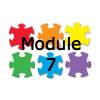0.2 – How This Course is Organized
If you’ve ever taken an online course before, you know that there can be considerable variance in the design and layout from one course to another. The same can be said of teachers who teach the same lesson, right? So, whether you’ve taken an online course before, or perhaps this is your very first one—we make no assumptions about how you’ll interpret what you see and how you experience it. To ensure a common understanding of the course layout and approach, this section includes two resources to guide your initial exploration of our learning environment as we have designed it. First, we’ll explain the layout through the text and a graphic organizer in the section labelled, “A Modular Approach.” Then, you’ll watch the guided video tour of the layout and navigation of the course, which explores the layout of the course and also includes some tips to add to your success as a participant in the section labelled, “Virtual Tour.” Let’s go!
A Modular Approach
This course is organized by a basic structure we call a “module.” You might think of a “module” as a “unit” of study. Each module lasts for three days, meaning that from 8:00 am on the first day of the module until 11:59 pm on the third day of the module, you will engage in course activities that must be completed during that module.
So, 1 module = 3 days
The modules in this course build upon one another, and are in many ways similar to puzzle pieces, hence the “puzzle” motif we’ve adopted throughout this course. Each module can be thought of as a piece of a larger puzzle. For each module, we provide you with content and activities that help you to develop and check your understanding of the focus for that module. The content and activities are divided into “sections”. These sections are labelled using a numerical identifier that helps you keep track of where you are in the course. Take a look at the following example:
In the section named 2.3 The Role of Authentic Content, the number “2” represents the Module and the number after the decimal, “3,” represents the third section of that Module.
All together, these sections make up each module, which is akin to one piece of the puzzle we are building together: Teaching languages online using a backward design approach. By itself, each module is interesting and provides us some insight into the larger task—our completed puzzle on using the backward design approach to teaching languages online.
There are seven modules in this course. The first four modules help prepare you for the online teaching you will do in this program, the first of which will be a microteaching activity conducted with a small set of your peers. Modules five and six of this course provide you the time to develop, teach, assess and reflect on your online peer microteaching experience. Then you will have a week to co-develop your synchronous online lesson for students at California State University, San Bernardino (CSUSB). During this week we will support you with two web conferences, feedback opportunities from our language specialists and time to practice your lesson using our web conferencing system, Adobe Connect. During our last week together you and your peers will co-teach a 60-minute synchronous lesson to students at CSUSB. Module seven in that week will help you reflect on your experiences in this course and how you can create a personalized growth plan for your future online teaching.
The modules of this course are as follows:
 | Designing for Student Success | Exploring the frameworks that shape our work in this course |
 | Creating Meaningful Cultural Contexts | Identifying authentic content for use in an upcoming synchronous, online peer microteaching episode (a mini teaching activity) |
 | Developing Performance-Based Activities | Creating performance-based activities and assessments that are appropriate for our learners and online learning environments |
 | Assessment for Learning: A Growth Mindset Practice | Deepening our knowledge of assessment, viewed through the lens of a Growth Mindset |
 | Planning the Performance and Peer Feedback Loop | Conducting a synchronous micro-lesson to a small group of your peers using Google Hangouts and giving each other feedback on these micro-lessons |
 | Peer Microteaching Performance and Feedback | Participating in a debriefing session on your microteaching experiences and exploring co-teaching in online environments |
 | Looking Back, Looking Forward: Debriefing Meeting | Reflecting on the previous modules and major course activities that have helped us to assemble all of the pieces into a beautiful puzzle |
Once a module has been “opened,” it will remain open for the duration of the course. As we begin each new module, that module will appear near the top of the course homepage, with the previous module just below it. In this way, you can easily access the current material.
